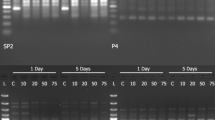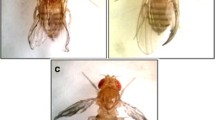Abstract
We tested a working hypothesis of whether the synthetic pyrethroid cypermethrin, used worldwide for insecticidal purpose, causes adverse effects on reproduction in Drosophila melanogaster. Freshly eclosed first instar larvae of a transgenic strain of Drosophila melanogaster, Bg 9, transgenic for hsp70 (hsp70-lacZ), were transferred to different dietary concentrations of the test chemical (0.002, 0.02, 0.2, 0.5, and 50.0 ppm). Larval mortality was observed at the higher dosed groups (0.2, 0.5, and 50.0 ppm). Following pair mating of virgin flies emerging from the treatment groups, a significant (p < 0.05) effect on reproduction was observed in the lowest two dietary concentrations of the test chemical as compared to control. The test chemical exhibited a hazardous effect on the reproductive organs of the exposed organism as evident by Hsp70 expression and tissue damage. The impact of damage was comparatively more prominent in male flies than in females. Hsp70 expression was restricted only within the testis lobes of male, while ovary in the female fly did not exhibit any Hsp70 expression. Interestingly, the accessory glands of male flies in these treatment groups reflected intense tissue damage as evident by Trypan Blue staining. This was further corroborated by ultrastructural changes like higher vacuolization and disorganized filamentous bodies in the accessory glands of these groups. The present study indicates a profound effect on reproduction by cypermethrin and suggests the protective role of hsp70.




Similar content being viewed by others
References
Abassy MA, Eldefrawi ME, Eldefrawi AT (1983) Pyrethroid action on nicotinic acetylcholine receptor/channel. Pestic Biochem Physiol 19:299–308
Ait-Aissa S, Porcher J, Arrigo A, Lambrey C (2000) Activation of the hsp70 promoter by environmental inorganic and organic chemicals: relationships with cytotoxicity and liphophilicity. Toxicology 145:147–157
Ashburner M (1982) The effects of heat shock and other stress on gene activity: an introduction. In: Schlesinger MJ, Ashburner M, Tissiéres A (eds) Heat shock proteins: From bacteria to man. Cold Spring Harbor Laboratory Press, Cold Spring Harbor, New York, pp 1–9
Bairati A (1968) Structure and ultrastructure of the male reproductive system in Drosophila melanogaster. Meig Monitore Zool (Ital) 2:105–182
Becker J, Craig EA (1994) Heat-shock proteins as molecular chaperones. Eur J Biochem 219:11–23
Bell EM, Hertz-Picciotto I, Beaumont JJ (2001) A case-control study of pesticides and fetal death due to congenital anomalies. Epidemiology 12:148–156
Benford DJ, Hanley AB, Bottrill K, Oehlschlager S, Balls M, Branca F, Castegnaro JJ, Descotes J, Hemminiki K, Lindsay D, Schilter B (2000) Biomarkers as predictive tools in toxicity testing. ATLA 28:119–131
Bonnier G (1960) Experiments on hybrid superiority in Drosophila melanogaster. II. Rate of development from egg hatching to eclosion. Genetics 46:86–91
Briganti S, Picardo M (2003) Antioxidant activity, lipid peroxidation and skin diseases. What’s new. J Eur Acad Dermatol Venereol 17:663–669
Chadwick PR (1962) Studies on the sub-lethal effect of pyrethrins on the grain weevil, Calandra oryzae L. Pyrethrum Post 6:20–26
Chen H, Xiao J, Hu G, Zhou J, Xiao H, Wang X (2002) Estrogenicity of organophosphorous and pyrethroids pesticides. J Toxicol Environ Health A65:1419–1435
Chen PS, Stumm ZE, Aigaki T, Balmer J, Bienz M, Bohlen P (1988) A male accessory gland peptide that regulates reproductive behavior of female Drosophila melanogaster. Cell 54:291–298
Craig EA, Weissman JS, Horwich AL (1994) Heat shock proteins and molecular chaperones: mediators of protein conformation and turnover in the cell. Cell 78:365–372
de Pomerai D (1996) Heat shock proteins as biomarkers of pollution. Hum Exp Toxicol 15:279–285
Dix DJ, Hong RL (1998) Protective mechanisms in germ cells: stress proteins in spermatogenesis. Adv Exp Med Biol 444:137–143
Dorman DC, Beasley VR (1991) Neurotoxicology of pyrethrin and the pyrethroids insecticides. Vet Human Toxicol 33:238–243
Elbetieha A, Daas SI, Khamas W, Darmani H (2001) Evaluation of the toxic potentials of cypermethrin pesticide on some reproductive and fertility parameters in the male rats. Arch Environ Contam Toxicol 41:522–528
Gayathri MV, Krishnamurthy NB (1981) Studies on the toxicity of mercurial fungicide Agallol3 in Drosophila melanogaster. Environ Res 24:89–95
Gonczy P, Viswanathan S, DiNardo S (1992) Probing spermatogenesis in Drosophila with P-element enhancer detectors. Development 114:89–98
Grajeda-Cota P, Ramirez-Mares MV, Gonzalez de Mejia E (2004) Vitamin C protects against in vitro cytotoxicity of cypermethrin in rat hepatocytes. Toxicol In Vitro 18:13–19
Gruwez G, Hoste C, Lints CV, Lints FA (1971) Oviposition rhythm in Drosophila melanogaster and its alteration by a change in the photoperiodicity. Experientia 27:1414–1416
Kalb LM, DiBenedetto AJ, Wolfner MF (1993) Probing the function of Drosophila melanogaster accessory glands by direct cell ablation. Proc Natl Acad Sci 90:8093–8097
Kar Chowdhuri D, Saxena DK, Vishwanathan PN (1999) Effect of hexachlorocyclohexane (HCH), its isomers, and metabolites on Hsp70 expression in transgenic Drosophila melanogaster. Pestic Biochem Physiol 63:15–25
King A (1985) The origin and functioning of insect oocytes and nurse cells. In: Kerkut GA, Gilbert LI (eds) Comprehensive insect physiology, biochemistry and pharmacology, vol. 1. Pergamon Press, Oxford, England, pp 37–82
Krebs RA, Feder ME (1997) Tissue specific variation in hsp70 expression and thermal damage in Drosophila melanogaster larvae. J Exp Biol 200:2007–2015
Lakhotia SC, Mukherjee T (1980) Specific activation of puff 93D of Drosophila melanogaster by benzamide and the effect of benzamide on the heat shock induced puffing activity. Chromosoma (Berl) 81:125–136
Lakhotia SC, Prasanth KV (2002) Tissue- and development- specific induction and turnover of hsp70 transcripts from loci 87A and 87C after heat shock and during recovery in Drosophila melanogaster. J Exp Biol 205:345–358
Lewis S, Handy RD, Cordi B, Billinghurst Z, Depledge MH (1999) Stress proteins (hsps): methods of detection and their use as an environmental biomarker. Ecotoxicology 8:351–368
Lindquist S, Craig EA (1988) The heat shock proteins. Annu Rev Genet 22:631–677
Lints FA (1971) Life span in Drosophila. Gerantology 17:33–51
Lis JT, Simon JA, Sutton CA (1983) New heat shock puffs and β-galactosidase activity resulting from transformation of Drosophila with an hsp70-lacZ hybrid gene. Cell 35:403–413
Loof AD, Hybrechts R (1998) Insects do not have sex hormones: A myth. Gen Comp Endocrinol 111:245–260
Lunning KG (1966) Drosophila test in pharmacology. Nature 209:40–49
Medina M, Barata C, Telfer T, Baird DJ (2002) Age-and sex related variation in sensitivity to the pyrethroids cypermethrin in the marine copepod Acartia tonsa Dana. Arch Environ Contam Toxicol 42:17–22
Morimoto RI, Jurivich DA, Kroeger PE, Mathur SK, Murphy SP, Nakai A, Sarge AK, Abravaya K, Sistonen ST (1994a) Regulation of heat shock gene transcription by a family of heat shock factors. In: Morimoto RI, Tissieres A, Georgopoulos C (eds.), The Biology of heat shock proteins and molecular chaperones. Cold Spring Harbor Laboratory Press, Cold Spring Harbor, New York, pp 610–620
Morimoto RI, Tissiéres A, Georgopoulous C (1994b) The biology of heat shock proteins and molecular chaperones. Cold Spring Harbor Laboratory Press, Cold Spring Harbor, New York
Mukhopadhyay I, Nazir A, Mahmood K, Saxena DK, Das M, Khanna SK, Kar Chowdhuri D (2002a) Toxicity of argemone oil: Effect on hsp70 expression and tissue damage in transgenic Drosophila melanogaster (hsp70-lacZ)Bg 9. Cell Biol Toxicol 18:1–11
Mukhopadhyay I, Nazir A, Saxena DK, Kar Chowdhuri D (2002b) Toxicity of cypermethrin: hsp70 as a biomarker of response in transgenic Drosophila. Biomarker 7:501–510
Mukhopadhyay I, Kar Chowdhuri D, Bajpai M, Dhawan A (2004) Evaluation of in vivo genotoxicity of cypermethrin in Drosophila melanogaster using the alkaline Comet assay. Mutagenesis 19:85–90
Narahashi T (1996) Neuronal ion channels as the target sites of insecticides. Pharmacol Toxicol 79:1–14
Narahashi T (2000) neuroreceptors and ion channels as the basis for drug action: past, present, and future. J Pharmacol Exp Ther 294:1–26
Nazir A, Mukhopadhyay I, Saxena DK, Kar Chowdhuri D (2003a) Evaluation of toxic potential of captan: Induction of hsp70 and tissue damage in transgenic Drosophila melanogaster (hsp70-lacZ)Bg 9. J Biochem Mol Toxicol 17:98–107
Nazir A, Saxena DK, Kar Chowdhuri D (2003b) Induction of hsp70 in transgenic Drosophila: biomarker of exposure against phthalimide group of chemicals. Biochem Biophys Acta 1621:218–225
Nazir A, Mukhopadhyay I, Saxena DK, Kar Chowdhuri D (2003c) Evaluation of no observed adverse effect level of solvent dimethyl sulfoxide in transgenic Drosophila melanogaster. Toxicol Mech Methods 13:147–152
Neuhaus-Steinmetz U, Rensing L (1997) Heat shock protein induction by certain chemical stressors is correlated with their cytotoxicity, lipophilicity and protein-denaturing capacity. Toxicology 123:185–195
Nover L (1991) The heat shock response. CRC Press, Boca Raton, Florida
O’Kane CJ, Gehring WJ (1987) Detection in situ of genomic regulatory elements in Drosophila. Proc Natl Acad Sci 84:9123–9127
Palter BK, Watanabe M, Stinson L, Mahowald AP, Craig EA (1986) Expression and localization of Drosophila melanogaster hsp70 cognate proteins. Mol Cell Biol 6:1187–1203
Ruight GSF (1985) Pyrethroids. In: Kerkut GA, Gilbert LI (eds) Comprehensive insect physiology biochemistry and pharmacology, vol. 12. Pergemon Press, Oxford, England, pp 183–262
Salminen WFJ, Voellmy R, Roberts SM (1996) Induction of hsp 70 in HepG2 cells in response to hepatotoxicants. Toxicol Appl Pharmacol 141:117–123
Sambrook J, Fritsch EF, Maniatis T (1989) Molecular cloning, a laboratory manual. Cold Spring Harbor Laboratory Press, Cold Spring Harbor, New York
Sanders BM (1993) Stress proteins in aquatic organisms: an environmental perspective. Crit Rev Toxicol 23:49–75
Vaalavirta L, Tahti H (1995) Astrocyte membrane Na+, K(+)-ATPase and Mg(2+)-ATPase as targets of organic solvent impact. Life Sci 57:2223–2230
Velazquez JM, Lindquist S (1984) hsp70: nuclear concentration during environmental stress and cytoplasmic storage during recovery. Cell 36:655–662
Wolfner MF (1997) Tokens of love: functions and regulation of Drosophila male accessory gland products. Insect Biochem Mol Biol 27:179–192
Yokoyama N, Hirata M, Ohtsuka K, Nishiyama Y, Fujii K, Fujita M, Kuzushima K, Kiyono T, Tsurumi T (2000) Co-expression of human chaperone Hsp70 and Hsdj or Hsp40 co-factor increases solubility of over expressed target proteins in insect cells. Biochem Biophys Acta 1493:119–124
Zimmerman JL, Petri W, Meselson M (1983) Accumulation of a specific subset of Drosophila melanogaster heat shock mRNAs in normal development without heat shock. Cell 32:1161–1170
Acknowledgments
The authors are thankful to the Director, ITRC, for his support and interest throughout the study. The authors wish to thank Prof. S.C. Lakhotia, Cytogenetics Laboratory, Banaras Hindu University, Varanasi, for the Bg 9 fly strain, Prof. Susan Lindquist, Whitehead Institute, Cambridge, MA, and Prof. M.B. Evgenev, Engelhardt Institute of Molecular Biology, Moscow, Russia, for Drosophila Hsp70 monoclonal antibody (7Fb). M/S Aimco Pesticides India Ltd., India, is acknowledged for providing the technical grade cypermethrin. I.M. and H.R.S. were supported by the Council of Scientific and Industrial Research Senior Research Fellowships. Financial assistance from the Council of Scientific and Industrial Research and the Department of Biotechnology, Govt. of India, New Delhi (Grant No. BT/PRO 390/R&D/12/030/96), to D.K.C. is gratefully acknowledged. This report is ITRC communication no. 2146.
Author information
Authors and Affiliations
Corresponding author
Rights and permissions
About this article
Cite this article
Mukhopadhyay, I., Siddique, H.R., Bajpai, V.K. et al. Synthetic Pyrethroid Cypermethrin Induced Cellular Damage in Reproductive Tissues of Drosophila melanogaster: Hsp70 as a Marker of Cellular Damage. Arch Environ Contam Toxicol 51, 673–680 (2006). https://doi.org/10.1007/s00244-005-0169-6
Received:
Accepted:
Published:
Issue Date:
DOI: https://doi.org/10.1007/s00244-005-0169-6




